
Damselflies are flying insects of the suborder Zygoptera in the order Odonata. They are similar to dragonflies but are smaller and have slimmer bodies. Most species fold the wings along the body when at rest, unlike dragonflies which hold the wings flat and away from the body. Damselflies have existed since the Jurassic, and are found on every continent except Antarctica.

Enallagma cyathigerum is a species found mainly between latitudes 40°N and 72°N; It is widely distributed in the Palearctic, and the Nearctic species Enallagma annexum was at one time considered to be synonymous with it. The species can reach a length of 32 to 35 mm. It is common in many different countries including Russia, Sweden, Norway, Finland, the United States of America, and South Korea. Damselflies are an important link between the health of the aquatic ecosystem and its response to climate change.

The variable damselfly or variable bluet is a European damselfly. Despite its name, it is not the only blue damselfly prone to variable patterning.

The azure damselfly is a species of damselfly found in most of Europe. It is notable for its distinctive black and blue colouring. They are commonly found around ponds and lakesides during the summer.
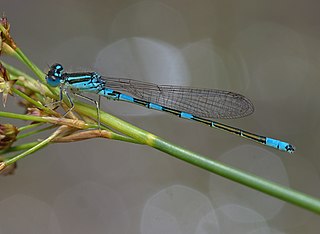
The dainty damselfly, also known as the dainty bluet, is a blue damselfly of the family Coenagrionidae. This is a scarce species found mainly in southern Europe, northern Africa, southwest Asia, and Central America. C. scitulum are Odonata predators that can reach a length of 30–33 mm at maturity and have hind-wing lengths of 15–20 mm. The males and females do exhibit differing features through their colouration making them easily distinguishable. As shown in the photo to the left, segment eight is blue in colour followed by black markings on segment nine, whereas the females are mostly black near the rear with smaller blue markings. Although they are relatively simple to sex, they are easily confused with the common blue damselfly.
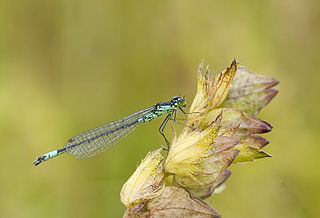
The Norfolk damselfly or dark bluet is a species of blue damselfly of the family Coenagrionidae native to Eurasia.

Coenagrion is a genus of damselflies in the family Coenagrionidae, commonly called the Eurasian Bluets. Species of Coenagrion are generally medium-sized, brightly coloured damselflies.
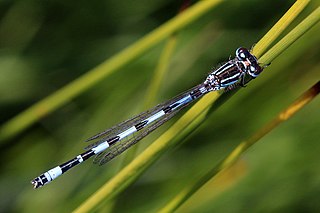
Coenagrion mercuriale, the southern damselfly, is a species of damselfly in the family Coenagrionidae. It is found in Algeria, Austria, Belgium, France, Germany, Italy, Liechtenstein, Luxembourg, Morocco, the Netherlands, Portugal, Romania, Slovakia, Slovenia, Spain, Switzerland, Tunisia, and the United Kingdom. Its natural habitats are rivers and freshwater springs. It is threatened by habitat loss.

Coenagrion hastulatum, the northern damselfly or spearhead bluet, is a damselfly in the family Coenagrionidae.
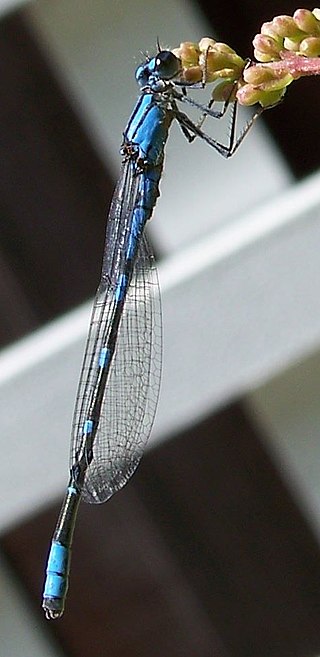
The tule bluet is a species of damselfly in the family Coenagrionidae found in North America, from northern Mexico to southern Canada.
The Cretan bluet is a damselfly in the family Coenagrionidae. It used to be a subspecies of Coenagrion ponticum

Coenagrion resolutum, the taiga bluet, is a damselfly which is part of the family of Coenagrionidae found in North America.
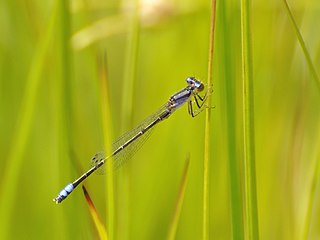
Proischnura polychromatica, the mauve bluet, is a small species of damselfly in the family Coenagrionidae. It is endemic to a small area of Cape Province in South Africa. The adult male has a mauve sheen to its dark-coloured body, a bronze-green thorax striped with mauve, and a pale brown abdomen with a bronze-green dorsal stripe. The female is mainly pale brown. The natural habitat of this damselfly is transient pools in stream beds with floating vegetation, especially sedges. Although previously more widespread, it is now known from a single location where it is threatened by the encroachment of cattle and the loss of suitable habitat. For these reasons, the International Union for Conservation of Nature has rated it as "endangered".

Coenagrion lyelli is a species of damselfly in the family Coenagrionidae, commonly known as a swamp bluet. It is a medium-sized damselfly, the male is bright blue with black markings. It is found in south-eastern Australia, where it inhabits streams, pools and lakes.
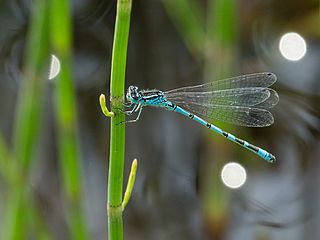
Coenagrion ornatum, or, the ornate bluet, is a species of damselfly from the family Coenagrionidae distributed across a large part of Europe and Western Asia.















